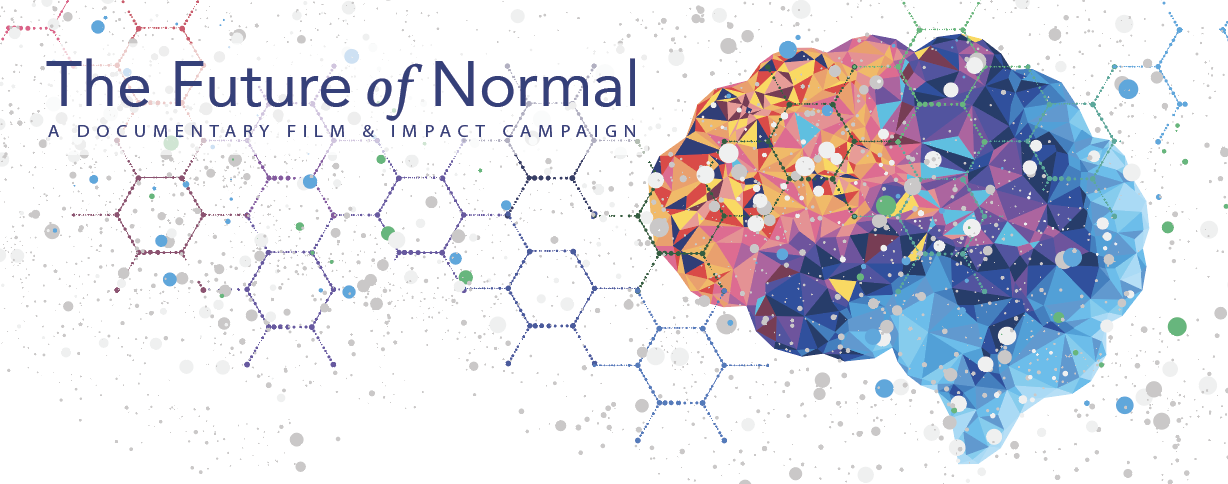“Variations in human cognition have always existed. The tragedy is not in the disabilities or differences, but in society’s failure to recognize and value all ways of being.”
Priya Lalvani, PhD
Professor of Disability Studies and Inclusive Education
There is no such thing as a “normal” way to think, act or learn.
The Future of Normal is a documentary film and impact campaign that explores neurodiversity through stories from people who are challenging our society’s rigid standards of conformity — and envisioning a future where all brains belong.
By bringing attention to neurodiversity, a concept that recognizes the rich spectrum of cognitive variability, The Future of Normal reaches into the fundamental structures of American society to examine the nature of human intelligence, the myriad ways that our brains can learn, and the rationale for embracing a new definition of normal.
The Future of Normal interweaves compelling personal stories that cross the lifespan and major sectors of society, interviews with thought leaders and neuroscientists, groundbreaking data and innovations, archival footage and dynamic motion graphics, as it explores the following core questions:
How did “normal” evolve to become the monolithic standard against which everyone in our society is measured, judged and categorized?
How do our systems that uphold this focus on conformity affect millions of individuals who think and learn differently?
What groundbreaking innovations and systemic changes are moving us towards a neuroinclusive future, where all brains belong?
20% of Americans have learning or attention issues.
That’s over 30 million people. It means that one in five of our relatives, our friends, our colleagues and our neighbors have minds that operate outside the neurological framework that has long been defined as “normal.” When something occurs with such a high frequency, is it really an anomaly?
For those who think and learn “differently”—with ADHD, dyslexia, autism or other neurodivergences—the pressure to conform starts even before kindergarten and continues throughout high school, college and into the workplace. Every difference is deemed a deficit to be fixed by special classes, prescriptions and corrective therapies. Students and adults are given labels that stigmatize them and accommodations that set them apart from their peers.
The next battlefield in the diversity movement is the human brain.
“Variations in human cognition have always existed. The tragedy is not in the disabilities or differences, but in society’s failure to recognize and value all ways of being.”
Priya Lavani, PhD
Professor of Disability Studies and Inclusive Education
Over the past few decades, hard-won battles have forged some progress in embracing diversities in race, culture and gender orientation, and life is more inclusive and accommodating for individuals with physical and intellectual disabilities. There are also millions of people in the US, who are neurologically diverse, with ADHD, dyslexia, or other cognitive divergences, including the autism spectrum. Pressure to fit in pervades every aspect of their lives, and is exacerbated by the fact that their differences are often invisible. If they don’t, or can’t, adapt they are ostracized and made to feel like they don’t belong. The result is an alarming loss of human potential and a devastating assault on human dignity.
The need to shift the public mindset around people who think and learn differently could not be more pressing. The Future of Normal provides a means to examine the societal tensions mentioned above, reflect on what makes us human, discover groundbreaking neuroscience, and learn about inclusive practices in education, health care and business that honor and accommodate the uniqueness of every individual.
THE FILM
After a brief introduction to the historical foundations for our country’s fixation with conformity and the dark legacy of generational harm that followed, the film centers on the personal stories of racially, geographically, and economically diverse neurodivergent individuals, who are challenging and changing the systems that have historically stigmatized them. Vérité-style shooting captures participants’ journeys as they unfold, highlighting issues of struggle and accomplishment, providing both narrative drama and emotional power, and connecting viewers to the issues in a deeply human way.
Trailblazing neuroscientists, philosophers, advocates, employers and educators will reveal innovative discoveries in neuroscience, contemplate what makes us human, debate the questions around the medical versus social model, and reveal glimpses of a future that recognizes, embraces and accommodates the vast spectrum of cognitive variability.
THE IMPACT CAMPAIGN
The Future of Normal impact campaign will start with the simple goal of putting the concept of neurodiversity in front of as many people as possible, raising awareness and generating dialogue. Only by grappling with our preconceived notions of normal can we pivot to building a movement to transform the systems that disenfranchise those who identify as neurodivergent. The Future of Normal campaign will motivate policy change in education and the workplace by generating demand for change from the ground up, recruiting new advocates to the cause, and initiating programs that exemplify best practices for inclusion and equity among decision makers. The Future of Normal sparks important conversations in halls of government, classrooms, and boardrooms. More than just a film, it is designed to amplify a movement.
For more detailed information visit futureofnormal.org

